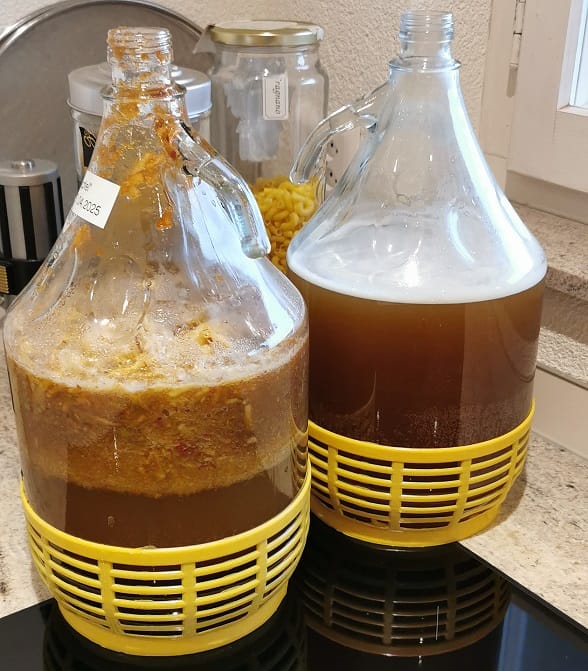Brewing Mead

Since i started with attending medieval fairs, i started to love mead. It is easy one of my favorite beverages. Since it seems fairly simple to brew it yourself, i started digging into the topic. Here you can read about my second but way more informed try that my girlfriend and i took.
Settling for a recipe
There are many ways to start brewing mead, many variations in ingredients both chemical and the base ones.
All of them mostly combine a base from water, apple juice and honey. Together with a good yeast and some special yeast nutrient salt.
The container we had at hand could contain about 4L of liquid. Since we have four containers and we want to not have a hassle later on, we decided to make two canisters full. The base recipe we settled on was base on "one third water, one third juice and one third honey". You could calculate how much alcohol is in the finished mead with the different approaches, but it was a good tip from someone who brew mead more often. You also need lactic acid to balance the acid level. Then there was also the tip to add in fresh apples to support the yeast more. We settled for a bio honey that was given to us from a befriended beekeeper.
In the end we settled for two base formulas:
Nature:
- 1.33 Liter Honey (You can calculate with the density, its about 1.84 Kilos of honey)
- 1.33 Liter water (you could add distilled but we have high quality from the faucet)
- 1.33 Liter "Most" (Apple juice, we settled for "mild most" from Rammseier)
- 2.0 Gram Yeast
- 2.0 Gram Yeast nutrient salt
Apple:
- 1.33 Liter apple juice
- 1.33 Liter honey
- approximately 1 Kilo of apple ¨sauce
- Top the rest with water (ca. 500 ml)
- 2.0 Gram Yeast
- 2.0 Gram Yeast nutrient salt
Ingredients and tools used
To aid some others that want to do the same, have some links to everything needed here:
- balloon's
- siphon's
- lactic acid
- Most / apple juice
- acidometer
- yeast
- yeast nutrient salt
- pipe with pump
- phials for measuring exact liquid amounts
- a fine scale for measuring the yeast
Brewing
The first step was to disinfect our fermentation balloon's on hand. Wash them with normal soap and when you cleaned them with water again just put them into an oven on ~ 120 degrees for around 20 minutes. After that we also cleaned them with a steam cleaner.
After that we had to get the honey into a liquid. Add 500 ml of water and also the amount of honey you need to a sauce pan and bring it to temperature. Its worthy to mention that some out there will tell you to only bring it up to around 30-40 degrees and never above 50 because it could kill the structure and alter the taste. However if you want to make sure that there is no other yeast, that could be doing bad things in your mead, then bring it up to about 73 degrees. We even had to to that because the honey was already fermenting by itself. So after bringing this water honey mixture up to temperature, let it cool off again.
In the meantime you can pour the "most" and the apples into the balloon. When the mixture has cooled down to about 23-25 degrees you can add it to the balloon's.
Now its time to find out how acidic your mixture is. The optimal value would be between 5.5 g/l (Gram per Liter) and around 7.5 g/l. The kit we used had a liquid that needed to be added into a phial until the mixture and this fluid turned into a specific color. Then you can calculate how much lactic acid needs to be added. One batch was miscalculated so we had a measurement of around 10-12 g/l. There is bacteria that can alter this and bring it down again later in the process. The apple one landed on approximately 6.5 g/l. Now you can add the yeast and the yeast salt to the balloon's. After a firm stir you can close them with the special siphons and that's that.
Yeast begins to work
After two days the yeast was already bubbling and you could hear and see that there is co2 escaping. Now we give it a firm shake every day and wait until the bubbling comes to a halt. Then we will subtract the mixture from the dead yeast and measure the alcohol level. You can then decide to add in another batch of honey to further increase the level. More in a later post.